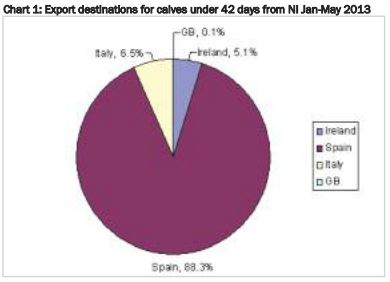



LMC: Calf Exports Increase With 88 per Cent Spain Bound
NORTHERN IRELAND - Although calf registrations have fallen, the number of calves being exported has risen so far this year to 10,568, 88 per cent of which go to Spain, according to industry experts at the Livestock and Meat Commission Northern Ireland.Calf exports out of Northern Ireland for further breeding and production have totalled 10,568 head during 2013 to date, write LMC analysts.
This is an increase of 1,193 head on the 9,375 head exported during the same period in 2012 and represents an increase of 13 per cent when comparing the two periods.
Calf exports for the year to date are now at similar levels to those recorded in 2011. This increase in calf exports has come about despite a 6 per cent decline in total calf registrations during 2013 to date when compared to the same period last year.
In the first five months of 2013 242,820 calves have been registered in NI, a decrease of 15,544 calves on the same period in 2012. This drop in calf registrations is likely to be a result of difficult production conditions last summer having a negative influence on cow fertility in both the dairy and suckler herds with a drop in the number of calves born as a result.
Almost all of the calves exported out of NI are dairy sired male calves which are destined for bull beef production on the continent. A total of 40,207 dairy sired male calves have been registered in 2013 to date, a drop of 5 per cent on the 42,211 calves registered in the same period in 2012.
Spain is the primary export destination for NI calves with 9,330 calves exported during 2013 to date, accounting for 88 per cent of all calf exports as outlined in Figure 1. In the same period last year exports to Spain totalled 7,666 head and accounted for 82 per cent of all calf exports.
The increase in exports to Spain in the first five months of 2013 represents a 22 per cent increase on the same period last year. The main production system in operation in Spain for Friesian bulls is a 12 month bull beef system which is based primarily on a diet of ad-lib cereals and straw.
The economics of these systems are more favourable in Spain due to the markedly lower input costs than in NI at present.
Meanwhile the export of 686 calves from NI to Italy for further breeding and production during 2013 to date has accounted for 6.5 per cent of total calf exports. This is up 1.3 percentage points from 5.2 per cent of calf exports during the same period in 2012.
NI calves which are exported to Italy are likely to be used in veal production systems. The increase in the number of NI born calves being exported to the continent for further production in 2013 to date may be due to a number of factors.
The increased strength of the euro against sterling in2013, lower calf prices and a drop in demand for Friesian bull calves from local producers has meant that the shippers can compete more readily for calves in NI and thus the increase in the number exported. The shippers are typically quoting £10-50 for Friesian bull calves this year compared to £60-100 last year.
The reduced demand for dairy-sired bull calves from producers in NI has been driven primarily by the increase in concentrate prices. Dairy calf to beef systems, particularly young bull beef production systems, are heavily reliant on high levels of concentrate inputs and with the current high cost of concentrates such production systems are difficult to work profitably.
The high levels of Holstein genetics in the NI dairy herd has also meant that many of the bull calves produced are of poor conformation and will not meet current processor requirements for beef production. There are however some opportunities for using these Friesian bull calves in veal production.
In addition the difficulties with grass production faced by producers operating dairy calf to beef systems last summer may have discouraged some producers from going down this route again.
This production system is reliant on maximising gain from grass and the poor performance of stock last summer led to cattle being below target weights at housing. This will have resulted in an increase in the costs of production in a system that already had tight margins as producers tried to
meet current market specifications on weight, age and fat cover.
TheCattleSite News Desk



